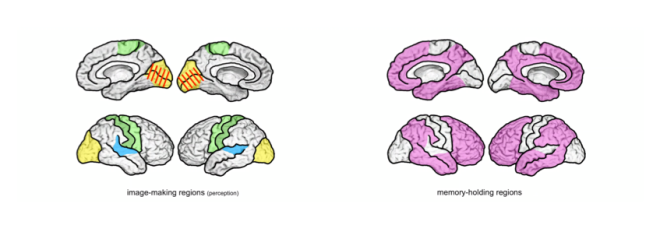Humanity appears to inhibit two realities (although dualism is disputed) and our consciousness is certainly the logical explanation, it is this ‘inner’ reality or the ‘self’ that holds our distinctive understanding of our daily lives. The modern age that we know today is a result of our mind's profound cognitive ability to interpret our surroundings, and most significantly be able to further convert our knowledge and experiences into something new entirely. We as humans share a unique ability above all other animals, we are able to construct and shape our entire world around us like never before, thriving on creativity and invention. In order to begin piecing together how creativity may have become possible, I think it’s important to briefly highlight the brain's ability to render and conjure images, illustrated in the images below. In the first image we have the visual cortex shown in yellow, green refers to tactile and blue auditory. The image-making regions then send signals to the memory-holding regions shown in purple.

The significant attribute of higher-consciousness is the ability to transmit information from our memory back to our visual cortex and also be able to fabricate our sense of self from these memories. ‘Simply put, the development of enormously complex re-entry neural circuits in the brain’ (See Lewis-Williams, 2002). A study on visual mental imagery and visual perception conducted by Giorgio Ganis, shows the brain's ability to transfer signals from memory to our visual cortex and established that visual imagery and visual perception draw on most of the same neural machinery. It is this trait in the brain's ability to later recall visual data and send it to the visual cortex that has initiated a number of theories with regard to prehistoric creativity. One particular theory supposes the brain's ability to recall visual images allowed for visions, such as dreams and altered states and suspected spiritual experiences which humans sought to transfer their visions to the ‘physical’.
Neuroscientist Antonio Damasio in a TED talk on ‘the quest to understand consciousness’ assumed that the motivation to communicate visually was induced by an understanding of time, the memory of before and the knowledge that they could transmit meaning beyond the confines of the self in the future. The observation of time is a plausible incentive for Paleolithic hominids to fabricate art that would supersede their own existence and various contemporary artists have expressed a similar motivation. In an earlier post I discussed the presentation conducted by Dr Jonathon Clark in which he spoke of the ‘longevity of art and the shortness of life’ and a comparable citation can be found in the Channel 4 ‘Who are you?’ with Grayson Perry; one of the subjects states ‘I’m fragile with the possibility of immortality, identity is fragile, and then what you leave from your identity is a possible legacy of some kind of immortality’. Visual communication has the capacity to convey one's self beyond the confines of mortality and without an appreciation for time, I highly doubt early hominids would have begun to devise what we know as the creative act.
Grayson Perry: Who are you? (2014). [TV programme] Channel 4, 22 October 2014
LEWIS-WILLIAMS, D. (2002) The Mind in the Cave: Consciousness and the Origins of Art. London: Thames & Hudson.
No comments.